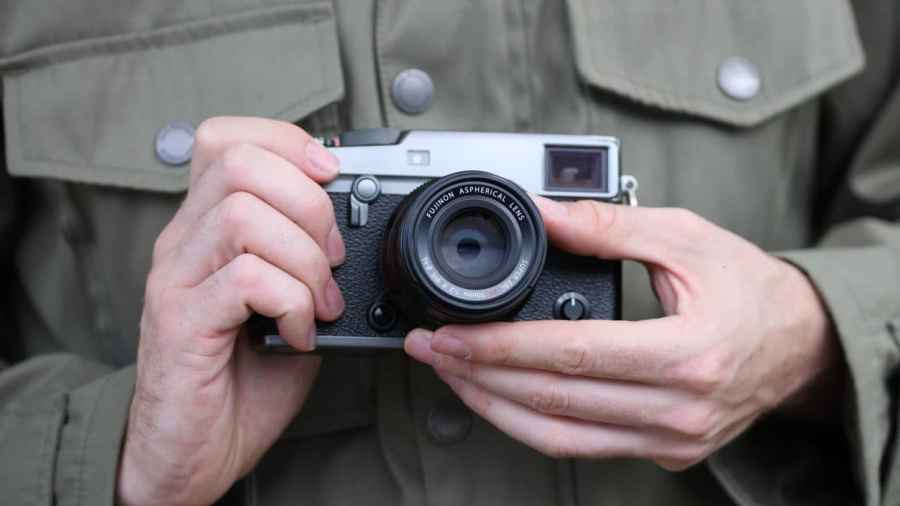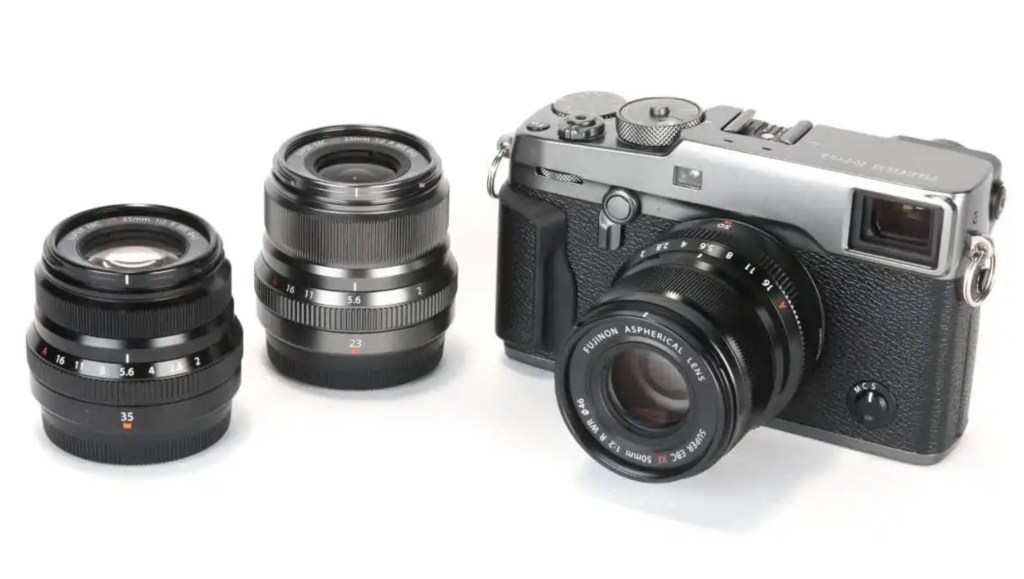When Fujifilm announced a smaller and lighter alternative to its XF 35mm f/1.4 R in the shape of the XF 35mm f/2 WR, everyone suspected it might be the first lens in a new series of primes in a range of Fujifilm X-Mount lenses.
What is the Fujifilm XF 50mm f/2 R WR?
It didn’t take long for Fujifilm to announce its next compact prime example. The XF 23mm f/2 R WR XF has become a popular choice with those who are after a more compact, weather-sealed alternative to the XF 23mm f/1.4 XF R.
At the start of the year, Fujifilm added another prime to its f/2 series with the release of the Fujinon XF 50mm f/2 R WR. This mid-telephoto prime offers a focal length that’s equivalent to 76mm and is an alternative to the Fujinon XF 56mm f/1.2 R – a lens that’s picked up a reputation for being one of the finest lenses for portraiture in the X-system.
With £300 separating the XF 50mm f/2 R WR from the XF 56mm f/1.2 R, it seems those who’ve held out for Fujifilm to release an affordable lens for shooting portraiture, travel, low-light and everyday subjects finally have what they’ve been waiting for.
Fujifilm XF 50mm f/2 R WR – Features
Although the lens is slower than the Fujifilm XF 56mm f/1.2 R, there are benefits to be had from manufacturing a smaller front element and limiting the maximum aperture to f/2.
The big appeal is its practical size and weight. When it’s placed alongside the XF 56mm f/1.2 R, you get a much better idea of just how petite it is. The difference in weight (205g) is noticeable when it’s paired with a Fujifilm X-series body – and in order to keep the lens as small and lightweight as possible, Fujifilm has developed an optical formula that arranges nine glass elements in seven groups.

Of these nine lens elements, one is an aspherical ED (extra low dispersion) lens, which is designed to minimise performance fluctuations between different focal distances and prevent spherical and chromatic aberrations. Just like the other lenses in Fujifilm’s series of f/2 primes, it features nine curved aperture blades that are designed to render striking spherical bokeh at wide apertures.
Thanks to its inner focusing system, users needn’t fret about the front element rotating or shifting back and fourth.
To ensure the focusing is both fast and silent, the lens inherits the same stepping motor as used inside the XF 35mm f/2 WR and XF 23mm f/2 R WR. If the lens performs as well as these lenses do, I anticipate faster and quieter focusing than you get on the XF 56mm f/1.2 R.

The WR abbreviation in its name highlights that this is one of Fujifilm’s weather-resistant lenses. It features no fewer than ten seals around the barrel to keep moisture and dust at bay, and you’ll find a rubber seal around the perimeter of the metal mount to prevent moisture or dust creeping inside the camera body.
Its weather-resistant status will appeal to outdoorsy types and those who don’t like the thought of having to stop shooting in inclement weather or challenging environments. Although there’s nothing to stop it being used with non-weather-sealed cameras, it’s likely to find itself being paired up with the manufacturers weather- and dust-resistant Fujifilm X-T2 and Fujifilm X-Pro2 bodies.

Another part of its spec not yet mentioned is its 46mm thread at the front for attaching filters and adapters. This is smaller than the 62mm filter thread on the XF 56mm f/1.2 R, and slightly larger than the 43mm filter thread on both the XF 35mm f/2 WR and XF 23mm f/2 R WR.
The lens’ minimum focus distance is another area where it has an advantage over the XF 56mm f/1.2 R. It has a maximum magnification of 0.15x and can focus within 39cm of a subject. By way of comparison, the XF 56mm f/1.2 R can only focus as close as 70cm.
Fujifilm XF 50mm f/2 R WR – Build and Handling
Compare this lens to Fujifilm’s wider f/2 primes and you’ll notice it’s a fraction longer than the XF 23mm f/2 R WR and not as stubby as the XF 35mm f/2 WR.
It has the same difference in diameter between the rear and the front of the lens, resulting in the aperture ring being slightly larger than the manual focus ring. In typical Fuji tradition, the aperture ring is located closest to the mount, meaning fingers of the supporting hand can find it easily without having to shift the holding position.

It’s constructed to the same high standard as its siblings in the f/2 range, and feels every bit as solid as you’d expect for a lens that’s designed to work as well on Fujifilm’s premium mirrorless cameras as it is on their enthusiast and entry-level models.
The fact it doesn’t have any switches on the barrel gives it a clean and stylish appearance. As well as having good aesthetics, it operates smoothly and precisely.

The aperture ring clicks through its range in 1/3-stop increments and offers a little more rotational resistance than you get on the XF 56mm f/1.2 R. This good level of feedback translates to a very satisfying user experience from behind the camera.
Rotating the aperture ring anti-clockwise to its furthest point sets it to its ‘A’ setting, where users can take control of shutter priority or let the camera decide on the best aperture setting in its Auto mode.

The electronically operated manual focus ring is nicely damped, too. It provides a comparable level of resistance to the XF 35mm f/2 WR and XF 23mm f/2 R in use, while the fairly long standard circular lens hood that’s supplied with the lens does a fine job of preventing flare-causing issues when shooting towards the light.
My review sample was supplied in black, but those who opted for an X-series camera in a silver finish will be glad to know this lens is also available in silver to match.
Fujifilm XF 50mm f/2 R WR – Autofocus
Fujifilm’s latest lenses have come a long way from early examples in terms of AF performance. Compare it to the Fujinon XF 56mm f/1.2 that was known for making some pesky whirring noises as it focused and you’ll notice this lens is a far quieter performer.

It isn’t entirely silent, however – you can still hear a faint clicking when the shutter is half-depressed and the aperture blades move, but on the whole it’s a big improvement.
Testing the lens with an X-Pro2 and then switching across to using the XF 56mm f/1.2 R also highlighted that this newer lens is perceptibly faster at locking on and acquiring focus.
Fujifilm claims the lens has a focus speed of 0.157sec – fractionally slower than the 0.053sec speed measured by the XF 23mm f/2 R WR lens.
Fujifilm XF 50mm f/2 R WR – Image Quality
The quality of the images created using this lens don’t disappoint, and by opening the lens to its widest aperture setting of f/2 it’s possible to create a pleasing separation between near and far subjects.
The quality of out-of-focus highlights means a lot to photographers who like to generate images with a shallow depth of field. Bokeh has a tendency to shift from circular in the centre to an elliptical shape at the edges.
Although it doesn’t create the same ‘dreamy’ feel to images as the more expensive XF 56mm f/1.2 R or XF 56mm f/1.2 APD ASPH lenses in Fujifilm’s lineup, it delivers a fine level of background blur that will satisfy the majority of those who use it.
Centre sharpness out-resolves corner sharpness at f/2, and the same can be said right through the aperture range to f/11, where the introduction of diffraction starts to soften overall sharpness.
Sharpness in the centre improves by stopping the lens down from f/2 to f/4, and there’s a very gradual improvement in corner sharpness from f/2 to where it peaks at f/8. To preserve optimum sharpness, users will ideally want to shoot between f/4-5.6 on this lens.
Examination of my Applied Imaging test alongside real-world images revealed visible levels of corner shading at the widest aperture, but this soon disappears when the lens is stopped down to f/2.8.
Even at f/2, vignetting from the lens isn’t distasteful. It’s tolerable for most applications and can be of benefit for portraiture and other subjects, where you’d like to encourage the viewer’s eye from the edge to the centre of the frame.
Chromatic aberration is handled reasonably well by the lens, with only minor fringes of colour being observed along some high-contrast edges at wide apertures.
Distortion isn’t a cause for concern on this lens either, and users should be aware that Fujifilm delivers correction for raw files via lens-specific metadata. This is accessed automatically by the Raw converter you use to correct or mitigate common optical phenomena. It’s the reason you won’t find Fujifilm lenses listed under lens profiles in Camera Raw or Lightroom.
Resolution
The results from my Applied Imaging tests revealed the lens gets gradually sharper in the centre when it’s closed down from its maximum aperture of f/2 to f/4. There’s a very gradual increase in corner sharpness between f/2 and f/5.6, with the sharpest results at the edge reaching their optimum at f/8. With centre and corner sharpness being affected by diffraction beyond f/8, we’d consider f/4-f/5.6 to be the lens’ sweet spot.

Shading
Vignetting is apparent in images taken at f/2, but it’s well controlled. Corners appear approximately 0.4EV darker than the centre and you’ll start to see an instant improvement as you begin to close the lens down from its maximum aperture. The vignetting correction that’s built into the raw file metadata did a commendable job of correcting corner shading on our raw files when processing through Lightroom CC.

Fujifilm XF 50mm f/2 R WR corner shading at f/2

Fujifilm XF 50mm f/2 R WR corner shading at f/4
Curvilinear distortion
Thanks to Fujifilm’s integration of software distortion correction (SDC), users can expect well-corrected JPEG and raw format files with virtually no curvilinear distortion. If you’d like to take full control over how much digital metadata distortion is applied, you’ll need to use software that allows you to do this – Iridient Developer and Capture One are two examples.

Fujifilm XF 50mm f/2 R WR – 0.4% TV SMIA
Should I buy the Fujifilm XF 50mm f/2 R WR?
X-series users aren’t short of choice when it comes to buying a fast mid-telephoto prime, but this lens has some key advantages. It’s a convenient size for travelling and feels just as good on smaller X-series camera bodies such as the Fujifilm X-T20 as it does with the more advanced Fujifilm X-T2 and Fujifilm X-Pro2 models.
Although it doesn’t create the same ‘dreamy’ look to its images at its widest aperture as the XF 56mm f/1.2 R or XF 56mm f/1.2 APD ASPH, it focuses faster, is quieter in operation and has the benefit of being weather-sealed.

The Fujifilm XF 50mm f/2 R WR (left) and the Fujifilm XF 56mm f/1.2 R (right)
Factor in that it can be bought with the XF 35mm f/2 R WR for only £30 more than you’d spend on the XF 56mm f/1.2 R, and you can see why these appealing little f/2 primes are so popular and continue to sell like hot cakes.

This review was originally published on Trusted Reviews











